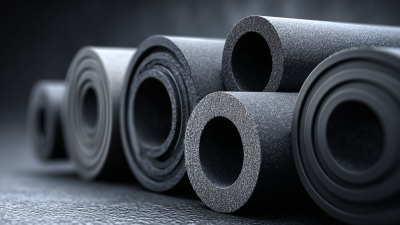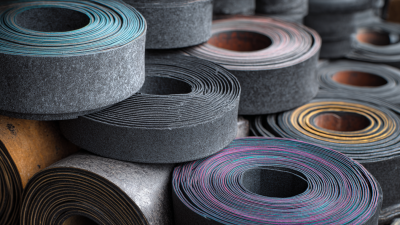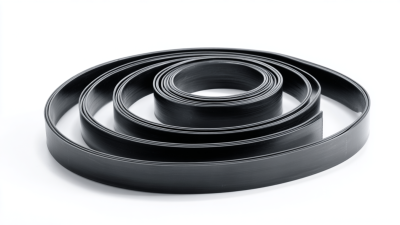How to Choose the Right Hnbr Viton for Your Industrial Applications
Table of Contents
- Understanding the Properties of HNBR and Viton: A Comparative Analysis
- Key Factors in Selecting HNBR and Viton for High-Temperature Applications
- Chemical Resistance: Evaluating HNBR and Viton for Industrial Use
- Cost-Effectiveness: Balancing Performance and Budget in Material Selection
- Longevity and Durability: Assessing Lifespan of HNBR vs. Viton in Harsh Environments
- Industry Standards and Certifications: Ensuring Compliance in Material Selection
- Exploring the Benefits and Applications of Oil Resistance HNBR Raw Polymer in Modern Industries
- FAQS
- Conclusion
- Related Posts
In the realm of industrial applications, selecting the appropriate materials is crucial for ensuring both performance and longevity. One such material, Hnbr Viton, is a type of fluoroelastomer recognized for its superior chemical resistance and thermal stability, making it ideal for demanding environments. According to a recent market analysis report, the global fluoroelastomers market is projected to reach $1.9 billion by 2026, with Hnbr Viton playing a significant role in this growth due to its versatility and reliability.

Sichuan Fudi New Energy Co., Ltd., established in 1998, has been a leader in the production and marketing of fluoroelastomer and other fluorinated rubber materials for over two decades. Our expertise in developing high-quality Hnbr Viton products positions us to assist industries in selecting the right materials that not only meet stringent operational requirements but also enhance overall efficiency.
Understanding the Properties of HNBR and Viton: A Comparative Analysis
When it comes to selecting elastomers for industrial applications, understanding the properties of HNBR (Hydrogenated Nitrile Butadiene Rubber) and Viton (Fluoroelastomer) is crucial. HNBR is known for its remarkable resistance to oils, fuels, and chemicals, making it a preferred choice in automotive and industrial environments where exposure to aggressive substances is common. Additionally, HNBR exhibits exceptional mechanical strength and durability, providing long-lasting performance in harsh conditions. Its ability to withstand moderate heat makes it suitable for various applications that involve fluctuating temperatures.
On the other hand, Viton is celebrated for its superior thermal stability and chemical resistance, particularly to fluorocarbon-based substances. This makes it an ideal candidate for applications in the aerospace and chemical industries where exposure to extreme conditions and corrosive agents is prevalent. Viton can operate efficiently at higher temperature ranges, often exceeding the capabilities of HNBR. However, it is generally less resistant to certain types of fuel and oils compared to HNBR. Therefore, the choice between HNBR and Viton should be based on a detailed analysis of the specific environmental conditions and chemical exposures anticipated in the intended application.

Key Factors in Selecting HNBR and Viton for High-Temperature Applications
When selecting HNBR (Hydrogenated Nitrile Butadiene Rubber) and Viton (Fluorocarbon Rubber) for high-temperature applications, several key factors should be taken into account. First, consider the temperature range of your application. HNBR generally performs well in temperatures up to 150°C, while Viton can withstand temperatures as high as 250°C. This makes Viton the ideal choice for more extreme conditions where thermal stability is a priority.
Another crucial factor is chemical resistance. Both HNBR and Viton offer excellent resistance to oils, fuels, and various chemicals, but their performance can vary based on specific substances. For instance, Viton excels in environments where aggressive chemicals are present, while HNBR may be more suitable for less demanding scenarios. It’s essential to analyze the specific chemicals involved in your application to ensure that the selected rubber can maintain its integrity and performance over time.
Finally, consider the mechanical properties required for your application. HNBR typically displays better tensile strength and abrasion resistance, making it advantageous for rugged environments, whereas Viton offers superior compression set resistance, which is essential in static sealing applications. Balancing these properties with the operational requirements of your industrial application will guide you in making the best choice between HNBR and Viton.
How to Choose the Right Hnbr Viton for Your Industrial Applications - Key Factors in Selecting HNBR and Viton for High-Temperature Applications
| Property | HNBR | Viton | Ideal Applications |
|---|---|---|---|
| Temperature Resistance | Up to 150°C (302°F) | Up to 200°C (392°F) | Automotive, Oil & Gas |
| Chemical Resistance | Excellent for oils and fuels | Good against fuels, acids, and solvents | Chemical Processing, Aerospace |
| Mechanical Strength | High tensile strength | Very high tensile strength | Heavy Machinery, Manufacturing |
| Flexibility | Good flexibility | Less flexibility at high temperature | Gaskets, Seals |
| Cost | Moderately priced | Higher cost than HNBR | Variety of industrial applications |
Chemical Resistance: Evaluating HNBR and Viton for Industrial Use
When selecting materials for industrial applications, chemical resistance is a critical factor to consider, particularly when evaluating HNBR (Hydrogenated Nitrile Butadiene Rubber) and Viton (Fluorocarbon Rubber). HNBR is renowned for its excellent resistance to oils, fuels, and a variety of chemicals, making it suitable for demanding environments such as automotive and oil exploration industries. Its performance in high-temperature scenarios also makes it a preferred choice for applications requiring durability against thermal degradation.
On the other hand, Viton offers superior resistance against a wider range of chemicals, particularly aggressive solvents and acids. This makes it an ideal choice for processes involving high levels of corrosion or exposure to extreme conditions. Although Viton can be more expensive than HNBR, its longevity and resilience often justify the cost in sectors like chemical processing and aerospace.
Therefore, assessing the specific chemical exposures and environmental conditions of your application will greatly influence your choice between HNBR and Viton, ensuring optimal performance and safety in your industrial operations.
Cost-Effectiveness: Balancing Performance and Budget in Material Selection
When selecting HNBR (Hydrogenated Nitrile Butadiene Rubber) Viton for industrial applications, cost-effectiveness is a critical factor that must be strategically assessed. According to a recent market analysis by MarketsandMarkets, the industrial rubber market is projected to grow from $25.9 billion in 2021 to $35.4 billion by 2026, reflecting a growing demand for high-performance materials. However, the challenge lies in balancing performance with budget constraints. HNBR Viton offers superior resistance to heat, oil, and chemicals, making it ideal for applications in automotive, oil and gas, and aerospace sectors. Choosing the right grade can significantly influence both operational efficiency and overall costs.

Investing in high-quality HNBR Viton may have a higher upfront cost, but it can result in substantial long-term savings. Data from the "Global HNBR Market Report" indicates that using high-grade HNBR materials can lead to a 20-30% reduction in maintenance costs due to their durability and longer lifespan compared to conventional materials. This not only lowers the frequency of replacements but also minimizes downtime, an important consideration for industries where operational continuity is paramount. Therefore, understanding the balance between short-term expenditure and long-term value is essential when selecting HNBR Viton for various industrial applications.
Longevity and Durability: Assessing Lifespan of HNBR vs. Viton in Harsh Environments
When assessing the longevity and durability of HNBR (Hydrogenated Nitrile Butadiene Rubber) compared to Viton (Fluoroelastomer) in harsh environments, it’s essential to consider their resistance to aggressive chemicals and temperature extremes. According to a report by the Rubber Manufacturers Association, HNBR typically operates effectively in temperatures ranging from -40°C to 150°C, with peak performance extending to 180°C in intermittent service. This thermal stability allows HNBR to maintain its integrity and operational functionality in various industrial settings, particularly in oil and gas applications.
In contrast, Viton exhibits remarkable resistance to a broader spectrum of chemicals, including acids and fuels, which makes it a preferred choice in applications requiring stringent chemical compatibility. The American Society for Testing and Materials (ASTM) notes that Viton can withstand continuous service temperatures of up to 200°C, with some grades resisting even higher temperatures. Furthermore, studies have shown that Viton retains its physical properties significantly better than HNBR when exposed to harsh environments, translating into a longer service life in demanding applications. Understanding these distinctions is crucial for selecting the right material that meets the specific demands of industrial applications, ensuring both operational efficiency and cost-effectiveness.
Industry Standards and Certifications: Ensuring Compliance in Material Selection
When selecting HNBR Viton for industrial applications, adherence to industry standards and certifications is crucial. These benchmarks ensure that the materials not only meet performance requirements but also comply with safety regulations. Organizations such as ASTM and ISO provide guidelines that define the necessary physical and chemical properties for materials used in specific environments. Compliance with these standards can significantly reduce the risk of material failure, which could lead to costly downtimes and safety hazards.
In addition to ASTM and ISO standards, certification by reputable bodies can further validate the suitability of HNBR Viton for your specific application. Certifications may indicate that the material has undergone rigorous testing regarding temperature resistance, chemical compatibility, and mechanical strength. By choosing materials that are certified, companies can enhance their operational reliability and ensure that they pass inspections and audits, which is critical for maintaining quality assurance in manufacturing processes. This proactive approach to material selection not only fosters compliance but also promotes a culture of safety and quality within the industry.
Material Compliance Standards for HNBR and Viton in Industrial Applications
This chart illustrates the compliance percentages of various standards and certifications relevant to HNBR and Viton materials in industrial applications. Ensuring compliance with these standards is crucial for safety, performance, and reliability in manufacturing processes.
Exploring the Benefits and Applications of Oil Resistance HNBR Raw Polymer in Modern Industries
The exploration of HNBR (Hydrogenated Nitrile Butadiene Rubber) highlights its remarkable advantages over traditional NBR (Nitrile Butadiene Rubber), particularly in terms of thermal and chemical performance. According to recent industry reports, HNBR demonstrates superior resistance to thermal oxidation, ozone, and radiation, making it an ideal choice for applications exposed to harsh environments. This durability ensures that products made from HNBR maintain their integrity much longer, which is a crucial factor in industries such as automotive and aerospace, where material failure can lead to significant operational downtime.
Furthermore, HNBR retains the oil resistance and wear resistance properties characteristic of NBR, combined with enhanced chemical medium resistance. It can withstand exposure to a variety of aggressive chemicals including acids, alkalis, and hydrogen sulfide, making it suitable for diverse applications in oil and gas, refrigeration, and automotive sectors. Industry data indicates that the use of HNBR can lead to a 30% longer service life in extreme conditions compared to conventional elastomers. With such outstanding properties, HNBR positions itself as a cutting-edge material in modern industrial applications, meeting the demands of both safety and efficiency.
For manufacturers and engineers seeking reliable solutions, the availability of stock samples allows for testing and evaluation without upfront investment. Any inquiries regarding HNBR or specific product requirements can be addressed promptly, emphasizing the commitment to support industrial needs with high-quality materials.
FAQS
: HNBR (Hydrogenated Nitrile Butadiene Rubber) is known for its excellent resistance to oils, fuels, and a variety of chemicals, making it suitable for demanding environments such as automotive and oil exploration industries.
Viton (Fluorocarbon Rubber) offers superior resistance to a wider range of chemicals, especially aggressive solvents and acids, making it ideal for processes with high levels of corrosion or extreme conditions.
Although Viton can be more expensive than HNBR, its longevity and resilience often justify the cost, particularly in sectors like chemical processing and aerospace.
The specific chemical exposures and environmental conditions of the application greatly influence the choice between HNBR and Viton to ensure optimal performance and safety.
The industrial rubber market is projected to grow from $25.9 billion in 2021 to $35.4 billion by 2026.
Investing in high-quality HNBR can lead to a 20-30% reduction in maintenance costs due to their durability and longer lifespan compared to conventional materials.
Both materials offer superior resistance to heat, oil, and chemicals, which can enhance operational efficiency and reduce overall costs.
Understanding this balance is essential because it impacts both short-term expenditures and long-term value in industrial applications.
Minimizing downtime is crucial for industries where operational continuity is paramount, and using durable materials like HNBR can help achieve this.
The choice of the right grade of rubber can significantly influence both operational efficiency and overall costs, enhancing long-term savings and performance.
Conclusion
Choosing the right HNBR and Viton for industrial applications requires a thorough understanding of their properties and the specific requirements of the application. HNBR, known for its high-temperature resistance, is compared with Viton, which offers excellent chemical resistance. Key factors in selection include temperature tolerance, chemical exposure, and cost-effectiveness, as businesses strive to balance performance with budget constraints.
Additionally, longevity and durability are critical when assessing material lifespan in harsh environments. Compliance with industry standards and certifications is essential to ensure the chosen materials meet safety and performance criteria. At Sichuan Fudi New Energy Co., Ltd., which specializes in the production of fluoroelastomers, understanding these factors allows us to provide high-quality HNBR and Viton products tailored to our customers' needs.
Related Posts
-

How to Choose the Right Fpm Gasket Material for Your Industrial Applications
-

Understanding Perfluoroelastomer O Rings Benefits and Applications in Global Markets
-

How to Choose the Right Viton Material for Your Industrial Needs
-

Ultimate Guide to Understanding the Benefits of Fkm Rubber in Industrial Applications
-

7 Reasons Why FKM Is Viton the Best Choice for Your Industrial Needs
-

How to Source Chemours FKM for Enhanced Performance in Your Applications
Blog Tags:

Charlotte
-

Phone
-

E-mail
-

Whatsapp
-

Top




